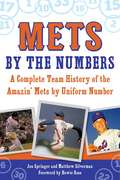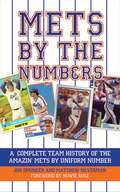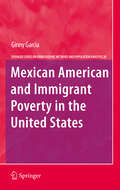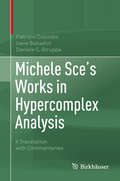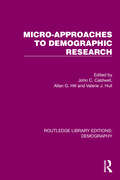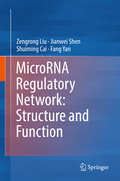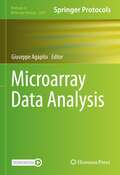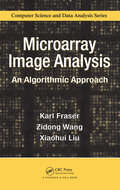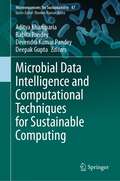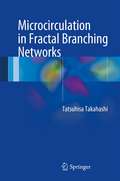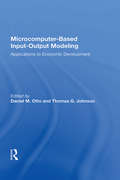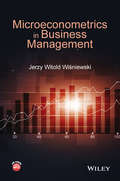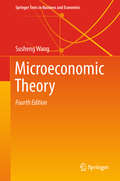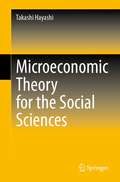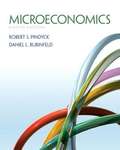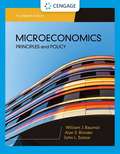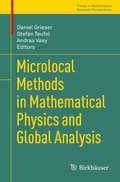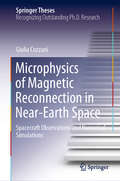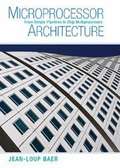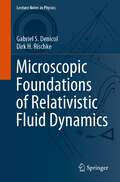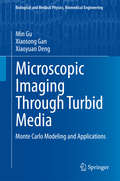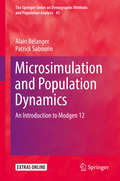- Table View
- List View
Mets by the Numbers: A Complete Team History of the Amazin' Mets by Uniform Number
by Matthew Silverman Jon Springer Howie RoseThis is the first team history of the New York Mets-or any other team-to be told through a lighthearted analysis of uniform numbers. Ordinary club histories proceed year by year to give the big picture. Mets by the Numbers uses jersey numbers to tell the little stories-the ones the fans love-of the team and its players.This newly revised edition is a catalog of the more than 700 Mets who have played since 1962, but it is far from just a list of No. 18s and 41s. Mets by the Numbers celebrates the team’s greatest players, critiques numbers that have failed to attract talent, and singles out particularly productive numbers, and numbers that had really big nights.With coverage of superstitions, prolific jersey-wearers, the ever-changing Mets uniform, and significant Mets numbers not associated with uniforms, this book is a fascinating alternative history of the Amazin’s.Skyhorse Publishing, as well as our Sports Publishing imprint, are proud to publish a broad range of books for readers interested in sports-books about baseball, pro football, college football, pro and college basketball, hockey, or soccer, we have a book about your sport or your team.Whether you are a New York Yankees fan or hail from Red Sox nation; whether you are a die-hard Green Bay Packers or Dallas Cowboys fan; whether you root for the Kentucky Wildcats, Louisville Cardinals, UCLA Bruins, or Kansas Jayhawks; whether you route for the Boston Bruins, Toronto Maple Leafs, Montreal Canadiens, or Los Angeles Kings; we have a book for you. While not every title we publish becomes a New York Times bestseller or a national bestseller, we are committed to publishing books on subjects that are sometimes overlooked by other publishers and to authors whose work might not otherwise find a home.
Mets by the Numbers: A Complete Team History of the Amazin' Mets by Uniform Numbers
by Matthew Silverman Jon SpringerThis is the first team history of the New York Mets-or any other team-to be told through a lighthearted analysis of uniform numbers. Ordinary club histories proceed year by year to give the big picture. Mets by the Numbers uses jersey numbers to tell the little stories-the ones the fans love-of the team and its players. This is a catalog of the more than 700 Mets who have played since 1962, but it is far from just a list of No. 18s and 41s. Mets by the Numbers celebrates the team's greatest players, critiques numbers that have failed to attract talent, and singles out particularly productive numbers, and numbers that had really big nights. With coverage of superstitions, prolific jersey-wearers, the ever-changing Mets uniform, and significant Mets numbers not associated with uniforms, this book is a fascinating alternative history of the Amazin's. 75 b/w photographs.
Mexican American and Immigrant Poverty in the United States
by Ginny GarciaThis book provides a comprehensive portrait of the experience of poverty among Mexican Americans and Mexican immigrants in the US. Given that these two groups experience some of the highest rates of poverty of any ethnicity and that it persists even while a majority work and reside in dual parent households, it becomes imperative that we explore a multitude of related factors. This book offers a systematic empirical analysis of these groups in relation to other ethnic groups, explores the individual and contextual factors associated with the determination of poverty via the use of logistic and multi-level models, details the historical context associated with Mexican immigrants, and discusses the major policies that have impacted them. It discusses the newest destinations of Mexican immigrants and also provides a discussion of undocumented migrants. Further, it details the current measure of poverty in the United States and offers a number of alternatives for modeling and measuring it.
Michele Sce's Works in Hypercomplex Analysis: A Translation with Commentaries
by Daniele C. Struppa Irene Sabadini Fabrizio ColomboThis book presents English translations of Michele Sce’s most important works, originally written in Italian during the period 1955-1973, on hypercomplex analysis and algebras of hypercomplex numbers. Despite their importance, these works are not very well known in the mathematics community because of the language they were published in. Possibly the most remarkable instance is the so-called Fueter-Sce mapping theorem, which is a cornerstone of modern hypercomplex analysis, and is not yet understood in its full generality.This volume is dedicated to revealing and describing the framework Sce worked in, at an exciting time when the various generalizations of complex analysis in one variable were still in their infancy. In addition to faithfully translating Sce’s papers, the authors discuss their significance and explain their connections to contemporary research in hypercomplex analysis. They also discuss many concrete examples that can serve as a basis for further research. The vast majority of the results presented here will be new to readers, allowing them to finally access the original sources with the benefit of comments from fellow mathematicians active in the field of hypercomplex analysis. As such, the book offers not only an important chapter in the history of hypercomplex analysis, but also a roadmap for further exciting research in the field.
Micro-Approaches to Demographic Research (Routledge Library Editions: Demography #3)
by Allan G. Hill John C. Caldwell Valerie J. HullOriginally published in 1988, this collection of essays was the first attempt by population scientists to incorporate some of the methods and materials of anthropologists into their work. The essays bridge the gap in the conceptualisation and organisation of field research by 2 sets of social scientists – demographers and social anthropologists – who share an interest in the explanation of particular patterns of population composition and change.
MicroRNA Regulatory Network: Structure and Function
by Zengrong Liu Jianwei Shen Shuiming Cai Fang YanThis book discusses topics related to the topological structure and biological function of gene networks regulated by microRNAs. It focuses on analyzing the relation between topological structure and biological function, applying these theoretical results to gene networks involving microRNA, illustrating their biological mechanisms, and identifying the roles of microRNA in controlling various phenomena emerging from the networks. In addition, the book explains how to control the complex biological phenomena using mathematical tools and offers a new perspective on studying microRNA. It is a useful resource for graduate students and researchers who are working on or interested in microRNAs and gene network.
Microarray Data Analysis (Methods in Molecular Biology #2401)
by Giuseppe AgapitoThis meticulous book explores the leading methodologies, techniques, and tools for microarray data analysis, given the difficulty of harnessing the enormous amount of data. The book includes examples and code in R, requiring only an introductory computer science understanding, and the structure and the presentation of the chapters make it suitable for use in bioinformatics courses. Written for the highly successful Methods in Molecular Biology series, chapters include the kind of key detail and expert implementation advice that ensures successful results and reproducibility. Authoritative and practical, Microarray Data Analysis is an ideal guide for students or researchers who need to learn the main research topics and practitioners who continue to work with microarray datasets.
Microarray Image Analysis: An Algorithmic Approach (Chapman & Hall/CRC Computer Science & Data Analysis)
by Karl Fraser Zidong Wang Xiaohui LiuTo harness the high-throughput potential of DNA microarray technology, it is crucial that the analysis stages of the process are decoupled from the requirements of operator assistance. Microarray Image Analysis: An Algorithmic Approach presents an automatic system for microarray image processing to make this decoupling a reality. The proposed syste
Microbial Data Intelligence and Computational Techniques for Sustainable Computing (Microorganisms for Sustainability #47)
by Deepak Gupta Aditya Khamparia Babita Pandey Devendra Kumar PandeyThis book offers information on intelligent and computational techniques for microbial data associated with plant microbes, human microbes etc. The main focus of this book is to provide an insight on building smart sustainable solutions for microbial technology using intelligent computational techniques. Microbes are ubiquitous in nature, and their interactions among each other are important for colonizing diverse habitats. The core idea of sustainable computing is to deploy algorithms, models, policies and protocols to improve energy efficiency and management of resources, enhancing ecological balance, biological sustenance and other services on societal contexts. Chapters in this book explore the conventional methods as well as the most recently recognized high-throughput technologies which are important for productive agroecosystems to feed the growing global population. This book is of interest to teachers, researchers, microbiologist, computer bioinformatics scientists,plant and environmental scientist, and those interested in environment stewardship around the world. The book also serves as an advanced textbook material for undergraduate and graduate students of computer science, biomedicine, agriculture, human science, forestry, ecology, soil science, and environmental sciences and policy makers.
Microcirculation in Fractal Branching Networks
by Tatsuhisa TakahashiThis book presents a new method for analyzing the structure and function of the biological branching systems of fractal trees, with a focus on microcirculation. Branching systems in humans (vascular and bronchial trees) and those in the natural world (plants, trees, and rivers) are characterized by a fractal nature. To date, fractal studies have tended to concentrate on fractal dimensions, which quantify the complexity of objects, but the applications for practical use have remained largely unexplored. This book breaks new ground with topics that include the human retinal microcirculatory network, oxygen consumption by vascular walls, the Fåhraeus-Lindqvist effect, the bifurcation exponent, and the asymmetrical microvascular network. Readers are provided with simple formulas to express functions and a simulation graph with in vivo data. The book also discusses the mechanisms regulating blood flow and pressure and how they are related to pathological changes in the human body. Researchers and clinicians alike will find valuable new insights in these pioneering studies.
Microcomputer Based Input-output Modeling: Applicatons To Economic Development
by Thomas G. Johnson Daniel M. OttoThis book discusses recent developments in Input-Output (I/O) models for microcomputers and applications of I/O models in regional studies. It provides background information on traditional I/O models and a set of working examples of I/O applications for users.
Microeconometrics
by A. Colin Cameron Pravin K. TrivediAn outstanding introduction to microeconometrics and how to do microeconometric research using Stata, this book covers topics often left out of microeconometrics textbooks and omitted from basic introductions to Stata. Cameron and Trivedi provide the most complete and up-to-date survey of microeconometric methods available in Stata. They begin by introducing simulation methods and then use them to illustrate features of the estimators and tests described in the rest of the book. They address each topic with an in-depth Stata example and demonstrate how to use Stata's programming features to implement methods for which Stata does not have a specific command. Multi/Card Deck Copy
Microeconometrics in Business Management
by Jerzy Witold WisniewskiThis book introduces the application of microeconometric methods for modelling various aspects of economic activity for small to large size enterprises, using methods that are based on both time-series and cross-section approaches. The information obtained from using these estimated models can then be used to inform business decisions that improve the efficiency of operations and planning. Basic models used in the modelling of the business (single-equation and multiple-equation systems) are introduced whilst a wide range of economic activity including major aspects of financial management, demand for labour, administrative staff and labour productivity are also explored. Microeconometrics in Business Management: Introduces econometric methods which can be used in the modelling of economic activity and forecasting, to help improve the efficiency of business operations and planning. Describes econometric entities through multiple-equation and single-equation microeconometric models. Explores the process of building and adapting basic microeconometric tools. Presents numerous micromodels based on time-series data and statistical cross-sectional sequences, which can be used in any enterprise. Features numerous real -world applications along with examples drawn from the authors own experience. Is supported by a companion website featuring practice problems and statistical data to aid students to construct and estimate micro models. Features end of chapter exercises with examples present in free software GRETL. This book serves as a valuable resource for students, business management practitioners and researchers in econometric micro-model construction and various decision-making processes.
Microeconometrics with R (Chapman & Hall/CRC The R Series)
by Yves CroissantThis book is about doing microeconometrics, defined by Cameron and Trivedi as "the analysis of individual-level data on the economic behavior of individuals or firms using regression methods applied to cross-section and panel data" with R. Microeconometrics became increasingly popular in the last decades, thanks to the availability of many individual data sets and to the development of computer performance.R appeared in the late nineties as a clone of S. It became increasingly popular among statisticians, especially in fields where S was widely used. Twenty years ago, using R for doing econometrics analysis required a lot of programming because a lot of core methods of econometrics were not available in R. Nowadays, most of the basic methods described in the book are available in contributed packages. Moreover, the set of packages called the tidyverse developed by RStudio (now Posit) for all the basic tasks of an applied statistician (importing, tidying, transforming and visualizing data sets) makes the use of R faster and easier. The book uses extensively specialized econometrics packages and the tidyverse, and it seeks to demonstrate that the adoption of R as the primary software for an econometrician is a relevant choice.The first part of the book is devoted to the ordinary least squares estimator. Matrix algebra is progressively introduced in this part, and special attention is paid to the interpretation of the estimated coefficients. The second part goes beyond the basic OLS estimator by testing the hypothesis on which this estimator is based and providing more complex estimators relevant when some of these hypotheses are violated. Finally, the third part of the book presents specific estimators devoted to "special" responses, e.g., count, binomial or duration data.Key Features: Many applications using data sets of recent academic works are developed Testing and estimation procedures using the programming framework of R and specialized packages are presented Two companion packages (micsr and micsr.data), containing respectively functions implementing some estimation and testing procedures not available in other contributed packages and data sets used in the book, are provided
Microeconomic Theory (Springer Texts in Business and Economics)
by Susheng WangThis book covers microeconomic theory at the Master’s and Ph.D levels for students in business schools and economics departments. It concisely covers major mainstream microeconomic theories today, including neoclassical microeconomics, game theory, information economics, and contract theory. The revamped, 3rd edition of "Microeconomic Theory" offers faculty, graduate and upper undergraduate students with a comprehensive curriculum solution.
Microeconomic Theory for the Social Sciences
by Takashi HayashiThis textbook covers microeconomic theory at the level of intermediate and advanced undergraduates. It is also intended as an introduction for those with other intellectual and academic backgrounds who may not necessarily agree with “mainstream” economists but at least are interested knowing how they think and see things.The book provides thorough explanations of definitions and assumptions that the theory is based upon. It provides comprehensive accounts of motivations and reservations behind the theory. As well, it precisely presents the logical process of how the assumptions lead to the conclusion, conveying the intuition and the key of the arguments. An abundance of topics is included here: individual choice, general equilibrium, partial equilibrium, game theory, imperfect competition, transaction under incomplete information, market failures, welfare economics, social choice and mechanism design. The book is a valuable resource for any reader studying or simply interested in microeconomic theory.
Microeconomics Eighth Edition
by Robert S. Pindyck Daniel L. RubinfeldA book that provides a treatment of microeconomic theory that stresses the relevance and application to managerial and public policy decision making.
Microeconomics: Principles and Policy (MindTap Course List)
by Alan Blinder William Baumol John SolowMaster today's principles of microeconomics and gain an understanding of current economic issues and their importance as Baumol/Blinder/Solow's MICROECONOMICS: PRINCIPLES AND POLICY, 14E provides a solid introduction to microeconomics using policy-based examples and applications. Written by several of today's most respected economists, this book is one of the most up-to-date microeconomics choices on the market -- incorporating data and issues as recent as 2018. The authors combine the right level of rigor and detail to clarify even the most complicated microeconomics concepts. An entirely new chapter closes the book by delving into some of the most important issues confronting the U.S. economy today. Throughout this edition, well-developed examples, intriguing puzzles and meaningful microeconomics issues provide an excellent balance of theory to application while keeping you engaged and intrigued.
Microlocal Methods in Mathematical Physics and Global Analysis
by Andras Vasy Daniel Grieser Stefan TeufelMicrolocal analysis is a field of mathematics that was invented in the mid-20th century for the detailed investigation of problems from partial differential equations, which incorporated and made rigorous many ideas that originated in physics. Since then it has grown to a powerful machine which is used in global analysis, spectral theory, mathematical physics and other fields, and its further development is a lively area of current mathematical research. In this book extended abstracts of the conference 'Microlocal Methods in Mathematical Physics and Global Analysis', which was held at the University of Tübingen from the 14th to the 18th of June 2011, are collected.
Microphysics of Magnetic Reconnection in Near-Earth Space: Spacecraft Observations and Numerical Simulations (Springer Theses)
by Giulia CozzaniThis book presents recent advances in the physics of magnetic reconnection, investigated via both in situ spacecraft observations and fully kinetic numerical simulations. Magnetic reconnection is a fundamental process in plasma physics during which the topological reconfiguration of the magnetic field leads to energy conversion and particle energization. The book focuses on the physics of the electron diffusion region (EDR), a crucial region where the electrons are decoupled from the magnetic field and efficiently accelerated by the electric field. By using recent, high-resolution measurements provided by NASA’s Magnetospheric MultiScale Mission (MMS), the book investigates the structure of the EDR at the Earth’s magnetopause. The presented analysis provides evidence for an inhomogeneous and patchy EDR structure. The structure of the EDR appears to be more complex than the in laminar picture suggested by previous observations and simulations. Then, electrons dynamics in the EDR is studied using a novel, fully kinetic Eulerian Vlasov–Darwin model that has been implemented in the Vlasov–DArwin numerical code (ViDA), explained in detail in the book. Lastly, the book covers the testing of this new code, and investigates the contributions of the different terms in the generalized Ohm’s law within the EDR, highlighting the role of the electron inertia term.
Microprocessor Architecture: From Simple Pipelines to Chip Multiprocessors
by Jean-Loup BaerThis book gives a comprehensive description of the architecture of microprocessors from simple in-order short pipeline designs to out-of-order superscalars. It discusses topics such as - the policies and mechanisms needed for out-of-order processing such as register renaming, reservation stations, and reorder buffers - optimizations for high performance such as branch predictors, instruction scheduling, and load-store speculations - design choices and enhancements to tolerate latency in the cache hierarchy of single and multiple processors - state-of-the-art multithreading and multiprocessing emphasizing single chip implementations Topics are presented as conceptual ideas, with metrics to assess the performance impact, if appropriate, and examples of realization. The emphasis is on how things work at a black box and algorithmic level. The author also provides sufficient detail at the register transfer level so that readers can appreciate how design features enhance performance as well as complexity.
Microscopic Foundations of Relativistic Fluid Dynamics (Lecture Notes in Physics #990)
by Gabriel S. Denicol Dirk H. RischkeThis book provides an introduction to relativistic dissipative fluid dynamics, with particular emphasis on its derivation from microscopic transport theory. After a phenomenological derivation of relativistic dissipative fluid dynamics from the second law of thermodynamics, the intrinsic instabilities of relativistic Navier-Stokes theory are discussed. In turn, analytical solutions of relativistic dissipative fluid dynamics are presented. Following, the authors discuss several theories and approaches to derive transport coefficients in dissipative fluid dynamics such as the Chapman-Enskog theory, the theory of Israel and Stewart, and a more recent derivation of relativistic dissipative fluid dynamics based on kinetic theory, which constitutes the main focus of the second part of this book. This book is intended for advanced graduate students and researchers in physics and requires basic knowledge of the theory of special and general relativity. It should be of particular interest to researchers that apply relativistic fluid dynamics in cosmology, astrophysics, and high-energy nuclear physics.
Microscopic Imaging Through Turbid Media
by Min Gu Xiaosong Gan Xiaoyuan DengThis book provides a systematic introduction to the principles of microscopic imaging through tissue-like turbid media in terms of Monte-Carlo simulation. It describes various gating mechanisms based on the physical differences between the un scattered and scattered photons and method for microscopic image reconstruction, using the concept of the effective point spread function. Imaging an object embedded in a turbid medium is a challenging problem in physics as well as in bio photonics. A turbid medium surrounding an object under inspection causes multiple scattering, which degrades the contrast, resolution and signal-to-noise ratio. Biological tissues are typically turbid media. Microscopic imaging through a tissue-like turbid medium can provide higher resolution than transillumination imaging in which no objective is used. This book serves as a valuable reference for engineers and scientists working on microscopy of tissue turbid media.
Microsimulation Population Projections with SAS: A Reference Guide (SpringerBriefs in Population Studies)
by Guillaume Marois Samir KCThis open access book provides a step-by-step overview on how to build a microsimulation model with SAS. It shows how to convert an already existing multistate projection by age, sex, education and region into a microsimulation model. Two new dimensions are then added, either the labor force participation and the sector of activity, and/or some examples of outputs and alternative scenarios that would not be possible with standard demographic methods. The book also describes how to adapt the model for other countries or other purposes. It also provides details on how to extend and adapt the model for other purposes as well as other use of microsimulation with SAS. The book suggests codes that are easy to understand, so they can be replicated or adapted for other purposes. As such, this book provides a great resource for people with beginner to intermediate knowledge in SAS.
Microsimulation and Population Dynamics
by Alain Bélanger Patrick SabourinThis book is a practical, step-by-step introduction to microsimulation in demography. It shows how to use Modgen, a powerful and free microsimulation platform built by Statistics Canada. The authors' hands-on explanation of model development will help readers make their own. The book teaches how to create and run a simple cohort model with a single fixed-rate event, and builds upon this concept. It introduces how to develop both a single state life table as well as a multiple increment-decrement life table using the tools provided by Modgen. The authors illustrate how to easily upgrade an existing model by adding new modules and new dimensions as determinants of a risk already modeled. The integration of a fertility module and a base population allows the user to bring new actors into the simulation and transform a cohort-based model into a population-based one. The final addition of an international migration module allows the user to accomplish fully open, multi-regional projections. This accessible introduction will be of interest to researchers and students in population studies and other social sciences. It will also appeal to anyone interested in the computational modeling of population dynamics.
